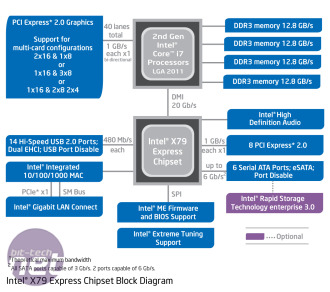Intel X79 Chipset: Facts and Fiction
We'll be reviewing a number of LGA2011 motherboards over the coming weeks on bit-tech, so the focus of this review is on the CPU, not these motherboards.However, because there has been so many contradictory rumours over the last few months, it's worth talking about the capabilities of the new Intel X79 chipset at the heart of these new LGA2011 motherboards.
The first rumour to clear up is about the PCI-E controllers built into the Sandy Bridge E CPU and X79 chipset. Disappointingly, the former is PCI-E 2.0, not PCI-E 3.0 (which provides greater bandwidth) as had been hoped. Even so, because the controller has 40 PCI-E 2.0 lanes it's still capable of full-speed CrossFire and SLI.
The lanes can divided up into up to three configurations as follows: two 16x slots and one 8x slot; one 16x slot and three 8x slots; one 16x slot, two 8x slots and two 4x slots.
However, as with other Intel PCI-E controllers, its up to the individual motherboard manufacturers to apply to Nvidia and AMD for SLI and CrossFireX certification. As this incurs a cost, expect SLI- and CrossFire-compatible boards to cost more than non-compatible.
The PCI-E controller in the X79 chipset is even less sophisticated than that of the CPU, as it only has eight PCI-E 2.0 lanes. The rest of the X79 chipset is pretty disappointing too - although it has six SATA connections, only two of these are high-speed SATA 6Gbps ports, the rest are of the older SATA 3Gbps variety that may well limit the performance of your SSD(s).
The X79 chipset also lacks the SAS 6Gbps ports it was originally supposed to include.
These have fallen by the wayside and may explain why Intel hasn't released Romley yet. After all, while SAS drives are rarely used by consumers, they are quite a common sight in workstations and servers.
Unlike the rest of the PC industry, Intel would appear to also still be holding its hands over its ears and singing 'La-la-la' when it comes to USB 3, as the X79 chipset is completely devoid of these connections.
This means that its up to motherboard manufacturers to add in this key ingredient of any modern PC as an extra controller. There's no sign of Thunderbolt to compensate for this lack of integrated high-speed peripheral connections either.

MSI MPG Velox 100R Chassis Review
October 14 2021 | 15:04











Want to comment? Please log in.